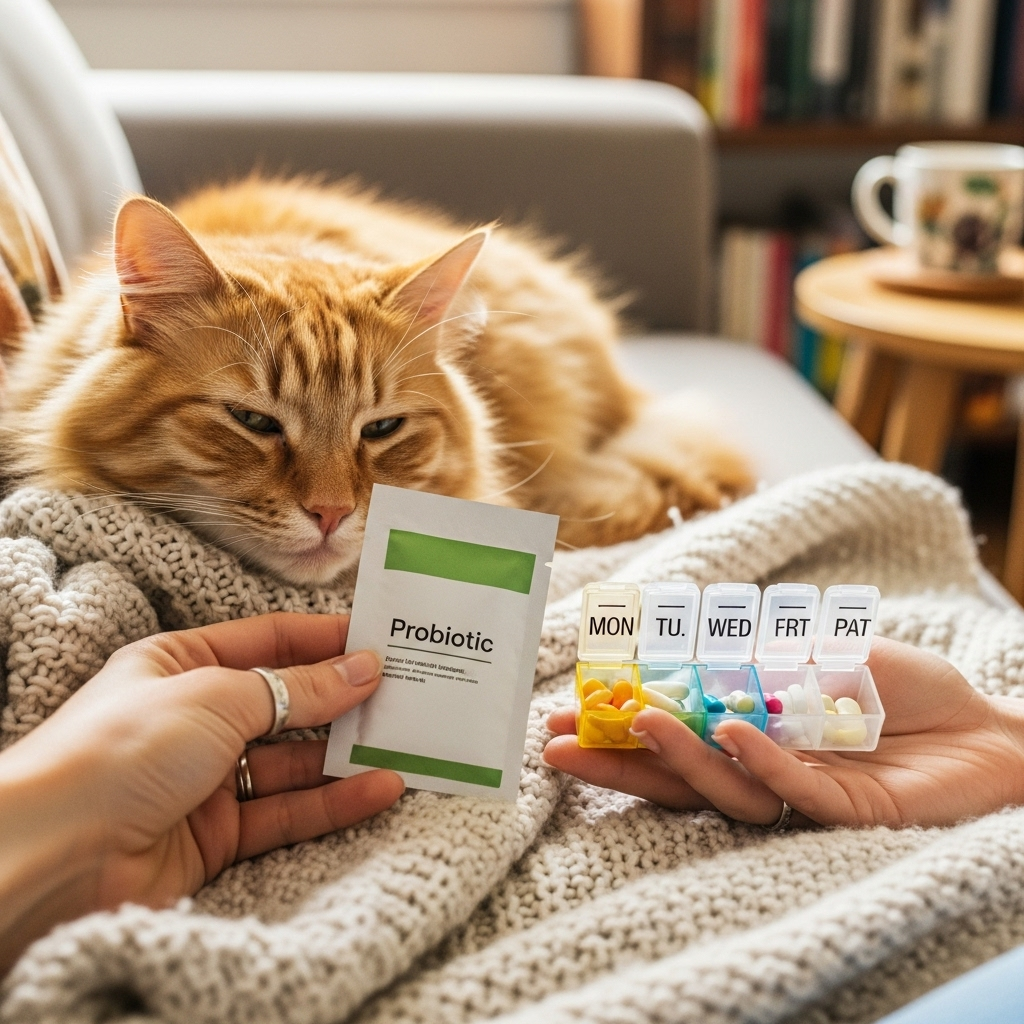When Should You Give Probiotics to Cats After Antibiotics?

Antibiotics can save your cat’s life, but they can also disturb the helpful bacteria that live in the gut. Probiotics — supplements that contain live beneficial microorganisms — are commonly recommended to help restore gut balance and reduce antibiotic-associated digestive upset. This article explains when and how to give probiotics to cats after antibiotics, which products are best for pets, what to watch for, and safety precautions every owner should know.
Why antibiotics affect your cat’s gut
Antibiotics target bacteria causing disease, but many also affect the diverse community of beneficial gut bacteria. Disruption of this microbiome can lead to loose stools, changes in appetite, gas, or less commonly, more serious issues. Restoring a healthy microbiome may help digestion, improve stool consistency, and support overall gut health.
When to give probiotics: timing and strategy
During antibiotic therapy
Many veterinarians recommend starting a probiotic while your cat is still on antibiotics. If you give both, separate the probiotic dose from the antibiotic dose by at least 1–2 hours so the antibiotic is less likely to kill the probiotic organisms. Some studies indicate that concurrent use can reduce the chance of antibiotic-associated diarrhea.
After finishing antibiotics
Continuing probiotics for 1–4 weeks after the antibiotic course can help repopulate beneficial bacteria and stabilize digestion. The exact duration depends on the antibiotic used, the severity of gut upset, and your cat’s health. Discuss a specific plan with your veterinarian.
Which probiotics are best for cats?
Not all probiotics are the same. Look for products formulated for cats or recommended by veterinarians. Key considerations:
- Strains: Common beneficial strains in veterinary products include Enterococcus faecium, Lactobacillus species, Bifidobacterium species, and the yeast Saccharomyces boulardii. Saccharomyces boulardii is often used during antibiotics because it is a yeast and not affected by antibacterial drugs.
- Product type: Veterinary probiotics, multi-strain formulas, and synbiotics (probiotics combined with prebiotics) are options. Prebiotics feed beneficial microbes and can aid recovery but may not be suitable for every cat.
- Stability and storage: Some probiotics require refrigeration; others are shelf-stable. Follow the manufacturer’s storage instructions to maintain potency.
- Labeling: Choose products that list strain names, colony-forming units (CFU) at time of manufacture or expiration, and clear dosing instructions.
How to give probiotics to your cat
- Get a veterinary recommendation first — especially for kittens, elderly cats, or cats with chronic illness.
- Follow the product’s dosing instructions. If the product is for pets, it will usually have an easy dosing guideline based on weight.
- Administer probiotics at least 1–2 hours away from an antibiotic dose if giving both the same day.
- Mix powders or capsules into a small amount of food, use a veterinarian-formulated paste, or give capsules directly if your cat tolerates them.
- Monitor your cat for improvement or any adverse reactions, and report concerns to your vet.
Signs your cat may benefit from probiotics after antibiotics
- Loose or watery stools during or after antibiotic treatment
- Sudden changes in stool frequency or consistency
- Mild and persistent digestive upset such as gas or reduced appetite once infection is clearing
If your cat has severe vomiting, bloody diarrhea, lethargy, or signs of systemic illness, contact your veterinarian right away — probiotics are supportive care and not a substitute for medical treatment.
Safety and precautions
Probiotics are generally safe for healthy cats, but there are important precautions:
- Immunocompromised or critically ill cats may be at higher risk of complications; give probiotics only under veterinary guidance.
- Using human probiotic products in cats is not always appropriate — formulations differ, and doses may not be suitable.
- Probiotics are a supplement and are not regulated like medications. Choose reputable brands formulated for pets or recommended by your veterinarian.
- If your cat develops worsening symptoms after starting a probiotic, stop it and contact your veterinarian.
Pros and Cons
| Pros | Cons |
|---|---|
| May reduce antibiotic-associated diarrhea and support gut recovery | Not all products are effective; quality varies |
| Can support digestion and overall microbial balance | Possible risk for immunocompromised or critically ill cats |
| Some strains (e.g., S. boulardii) aren’t affected by antibiotics | Product costs and the need for prolonged use in some cases |
What the research says
Veterinary research shows that certain probiotic strains can reduce the incidence and severity of antibiotic-associated diarrhea in dogs and cats, and may aid recovery of the gut microbiome. Results depend on the strain, dose, timing, and the specific antibiotic used. While evidence is promising, not every probiotic works the same way, and more studies are needed to define optimal formulas and durations for cats.
FAQ
1. Can I give my cat human probiotic capsules?
Human probiotics may contain different strains and doses that are not appropriate for cats. Some human products are safe but others are not ideal. Ask your veterinarian before using a human formulation.
2. How long should I continue probiotics after antibiotics?
Many veterinarians recommend continuing for 1–4 weeks after finishing antibiotics to help restore gut flora, but the exact duration should be individualized and guided by your cat’s response and your vet’s advice.
3. Should I start probiotics during or after antibiotics?
Both approaches are used. Starting during antibiotics can prevent diarrhea; if given concurrently, give the probiotic at least 1–2 hours apart from the antibiotic. If you start after, continue for several weeks to support recovery.
4. Are there any side effects?
Side effects are usually mild or rare and may include temporary gas or mild digestive changes. More serious complications are uncommon but possible in very sick or immunosuppressed cats.
5. Can probiotics replace other supportive care?
No. Probiotics are supportive and should be part of a treatment plan from your veterinarian. They do not replace necessary medications or diagnostics.
Key Takeaways
- Antibiotics can disrupt a cat’s gut bacteria; probiotics may help restore balance and reduce diarrhea.
- Start probiotics during antibiotics or immediately after — if used with antibiotics, separate doses by 1–2 hours.
- Choose veterinary-formulated products or strains supported by research; consult your vet before starting.
- Continue probiotics for several weeks post-antibiotics as advised by your veterinarian.
- Watch for adverse reactions and seek veterinary care for severe or worsening symptoms.
Disclaimer: This article provides general information and is not a substitute for professional veterinary advice. Before giving any supplement, including probiotics, consult your veterinarian to determine the best product, dose, and duration for your cat’s specific health needs.

Leave a Reply